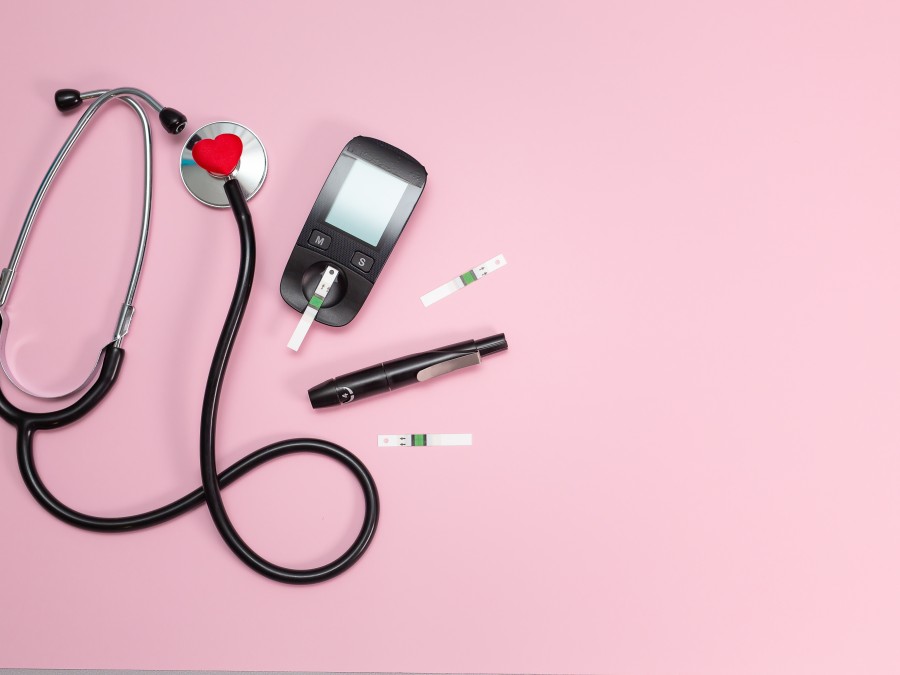Blood Glucose Levels: A Guide

Maintaining healthy blood glucose levels is an important part of living with diabetes and managing the condition.
Monitoring and maintaining stable blood glucose levels, along with other lifestyle changes, such as eating a balanced diet, engaging in physical activity, and maintaining weight are key for diabetes care and quality of life.
Find out more about why monitoring blood glucose is so important in our guide below.
What are blood glucose levels?
Blood glucose is the main source of energy for the cells in your body. Blood glucose is created when carbohydrates from your diet are metabolised. Glucose is then used immediately or stored in the liver and muscles for use later.
When you’ve had food, it gets digested into the gut and absorbed into the intestine, which leads to an increase in blood glucose levels. When fasting, blood glucose levels drop, and the liver helps keep the glucose in the body at a healthy level by making its own glucose. In both scenarios, the pancreas needs to secrete the hormone insulin, which is necessary for glucose to enter the cells, so that the cells can turn glucose into energy.
In diabetes, there is either an insufficient production of insulin (type 1 diabetes) or increased resistance to insulin (type 2 diabetes) — in both situations, this interferes with the ability to maintain healthy blood glucose levels. Therefore, understanding and monitoring blood glucose level ranges is a key part of managing all types of diabetes.
Why is it important to maintain blood glucose levels?
For a person living with diabetes, there is a risk of complications. These complications can be divided into two classes: microvascular and macrovascular.
Research shows that keeping blood glucose levels in check can decrease the risk of microvascular complications — that is, conditions that affect the small blood vessels.
Microvascular complications include:
- diabetic retinopathy, or complications that damage the eyes and may even lead to blindness
- diabetic neuropathy, or complications that damage the nervous system, such as diabetic foot, which may lead to amputation
- diabetic nephropathy, or conditions that affect the kidneys and renal system, such as chronic kidney disease
Macrovascular complications include:
- cardiovascular disease
- stroke
- peripheral artery disease, which may lead to bruises or injuries that do not heal, gangrene, and ultimately, amputation.
Well managed blood glucose levels may also prevent some of these complications, such as heart attacks, although the evidence here is less clear than in the case of microvascular complications.
However, a combined effort to keep blood glucose levels, cholesterol levels, and blood pressure levels managed in diabetes are beneficial and can minimise the risk of diabetes-related complications overall.
High blood glucose levels & hyperglycaemia
If someone has a blood glucose reading over 7.8 mmol/L (140 mg/dL), they are considered to have high blood glucose, or hyperglycaemia.
Hyperglycaemia can be caused by numerous factors, but in diabetes, it occurs when there is not enough insulin in the body or insulin is not used properly to help lower blood glucose.
Having hyperglycaemia can cause symptoms such as a frequent need to urinate, feeling increasingly thirsty, fatigued, having blurred vision, and having recurrent infections.
Untreated hyperglycaemia can lead to complications, some of which are life-threatening.
Low blood glucose levels & hypoglycaemia
Hypoglycaemia, or low blood glucose, is commonly defined as lower than 3.9 mmol/L (70 mg/dL).
In diabetes, it can occur as a side effect of taking insulin or other insulin-increasing drugs. It can also be caused by not consuming enough carbs, fasting, increasing physical activity, drinking too much alcohol without enough food, or being sick. Severe conditions such as liver diseases or kidney disease can also result in hypoglycaemia.
Symptoms of hypoglycaemia include feeling shaky, tired, hungry, irritable or confused, dizzy, or lightheaded. Additionally, you may have a rapid heartbeat and not feel able to think or speak clearly.
Severe hypoglycaemia may lead to seizures, loss of consciousness, coma, or even death. Other complications in the long- and short-term include hypoglycaemia unawareness, neurologic damage, trauma, and cardiovascular events such as angina and heart attack.
Recommended and expected blood glucose levels
The World Health Organization (WHO) and the American Diabetes Association (ADA), define blood glucose levels for adults aged 18 and older as:
- blood glucose levels when fasting (i.e. before breakfast or without having eaten anything in the previous 8 hours) are between 3.9 mmol/L (70 mg/dL) and 5.6 mmol/L (100 mg/dL)
- fasting blood glucose between 5.6 and 6.9 mmol/L (100 and 125 mg/dL) indicates that changes in lifestyle and monitoring blood glucose levels are necessary. According to the ADA, this constitutes prediabetes
- fasting blood glucose of 7 mmol/L (126 mg/dL) or higher on two separate tests suggests a diagnosis of diabetes
Blood glucose targets can vary from individual to individual, based on a number of factors such as:
- duration of diabetes
- age or life expectancy
- conditions a person may have
- cardiovascular disease other diabetes-related complications
- hypoglycaemia unawareness
- other individual patient considerations
It is important to remember that the above are just guidelines. A core element of blood glucose control is that targets should be personlised, based on a benefit-risk analysis carried out by you and your healthcare team.
Testing blood glucose levels
There are several ways in which you can test your blood glucose levels. You can do so yourself, or your healthcare team may recommend a set of specialised tests.
Self-monitoring can be done using either:
- A blood glucose meter and finger-prick test, also known as finger-stick test
- Continuous glucose monitoring systems (CGMs)
- Flash glucose monitoring systems (sometimes known as ‘intermittently scanned continuous glucose monitors’)
Your healthcare team may also test your blood glucose levels, especially to diagnose diabetes. These tests include:
- the HbA1C test, also known as the glycated haemoglobin test
- the fasting plasma glucose (FPG) test
- the random plasma glucose (RPG) test
- the oral glucose tolerance test (OGTT)
Testing blood glucose levels is essential for diagnosing diabetes promptly, managing the condition, and preventing potentially life-threatening complications.
Maintaining healthy blood glucose levels is a core element of diabetes care and self-management. Monitoring glucose levels in the blood through testing may help avoid micro- and macrovascular complications, prevent hypo- and hyper-glycaemia, and maintain quality of life for those living with diabetes.
Sources
- Davies, M. J., D’Alessio, D. A., Fradkin, J., Kernan, W. N., Mathieu, C., Mingrone, G., ... & Buse, J. B. (2018). Management of hyperglycaemia in type 2 diabetes, 2018. A consensus report by the American Diabetes Association (ADA) and the European Association for the Study of Diabetes (EASD). Diabetologia, 61(12), 2461-2498. https://link.springer.com/article/10.1007/s00125-018-4729-5
- “Blood glucose” topic overview, Science Direct, accessed February 26, 2022. https://www.sciencedirect.com/topics/agricultural-and-biological-sciences/blood-glucose
- “Carbohydrates,” Medline Plus, National Institutes of Health National Library of Medicine, accessed February 26, 2022. https://medlineplus.gov/carbohydrates.html
- Deshpande, A. D., Harris-Hayes, M., & Schootman, M. (2008). Epidemiology of diabetes and diabetes-related complications. Physical therapy, 88(11), 1254-1264. https://www.ncbi.nlm.nih.gov/pmc/articles/PMC3870323/
- Letters to the Editor, Glycemic Control Is an Important Consideration in Diabetes Care, Am Fam Physician. 2014 Oct 15;90(8):524-526. https://www.aafp.org/afp/2014/1015/p524.html
- “Hyperglycemia and hypoglycemia in type 1 diabetes,” InformedHealth.org [Internet]. Cologne, Germany: Institute for Quality and Efficiency in Health Care (IQWiG); 2006. Available from: https://www.ncbi.nlm.nih.gov/books/NBK279340/
- Mouri MI, Badireddy M. hyperglycaemia. [Updated 2021 May 10]. In: StatPearls [Internet]. Treasure Island (FL): StatPearls Publishing; 2022 Jan-. Available from: https://www.ncbi.nlm.nih.gov/books/NBK430900/
- “Hypoglycaemia (Low Blood sugar),” American Diabetes Association, accessed February 26, 2022. https://www.diabetes.org/healthy-living/medication-treatments/blood-glucose-testing-and-control/hypoglycemia
- “Low Blood Glucose (hypoglycaemia),” National Institute of Diabetes and Digestive and Kidney Diseases, U.S. Department of Health and Human Services, accessed February 26, 2022. https://www.niddk.nih.gov/health-information/diabetes/overview/preventing-problems/low-blood-glucose-hypoglycemia
- World Health Organization, “Mean fasting blood glucose,” accessed February 26, 2022. https://www.who.int/data/gho/indicator-metadata-registry/imr-details/2380
- Shafiee, G., Mohajeri-Tehrani, M., Pajouhi, M., & Larijani, B. (2012). The importance of hypoglycemia in diabetic patients. Journal of Diabetes & Metabolic Disorders, 11(1), 1-7. https://link.springer.com/article/10.1186/2251-6581-11-17
- “Understanding A1C Diagnosis,” American Diabetes Association, accessed February 26, 2022. https://www.diabetes.org/diabetes/a1c/diagnosis
- “The Big Picture: Checking Your Blood Sugar,” American Diabetes Association, accessed February 26, 2022. https://www.diabetes.org/healthy-living/medication-treatments/blood-glucose-testing-and-control/checking-your-blood-sugar
- American Diabetes Association; 13. Children and Adolescents: Standards of Medical Care in Diabetes—2019. Diabetes Care 1 January 2019; 42 (Supplement_1): S148–S164. https://doi.org/10.2337/dc19-S013
- “Diabetes Tests & Diagnosis,” National Institute of Diabetes and Digestive and Kidney Diseases, U.S. Department of Health and Human Services, accessed February 26, 2022. https://www.niddk.nih.gov/health-information/diabetes/overview/tests-diagnosis





